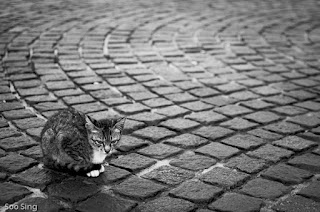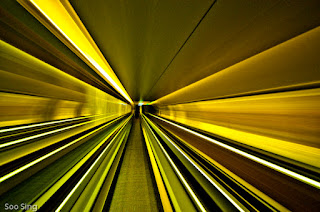A good photographer friend (Bryan Kam) asks if I'd be interested to shoot his wedding - he didn't look like he was joking, nor was he running a fever, so, nothing ventured, nothing gained - and I said yes of course! The only proviso was, I've never shot weddings before, so as long as he had a someone else taking the main event, I'm just a newbie taking, expect nothing and you won't be disappointed!
I can tell you I've never been so stressed in such a long time! Here's a list of learnings from me.
1.Equipment
I decided to try out Bryan's D700 paired with 24-70 (perfect combo!), together with my own D90 (which I used with ultra wide angle Tokina 11-16, switching with telezoom Nikon 80-200).
So the moment I reached Bryan's place in the morning, I spent half hour, going through the D700 settings, of which I think 80-90% are the same/familiar. So we're set!
I had also just started trying to use a flash. So I was experimenting shots with flash and without, and starting to like those with flash.
Bad, bad, bad.
A.Underexposure.
The exposure was all over the place, the screen shot often showed it under exposed at least 1 stop. So I had to keep looking to manually adjust the exposure.
B.Shutter speed
The D700 kept shooting at 1/15, when I shot at Aperture. I had set it to shoot at a min of 1/60, and to bump up ISO instead. It did not. I tried manual exposure, but when I inserted the flash unit, it really messed up the exposure meter. I had NO idea why, and no time to figure out. Just kept at Aperture priority; TTL and hoped for the best!
But not all is bad.
C.Lenses
Well, I can say that the 24-70 fits FX much better than my DX. It felt more natural, and useful range.
I also liked my 11-16 ultra wide angle shots. These were the 2 most used lenses.
I'm not sure I'm brave enough to go primes, although a 85 F1.4 would be nice (in theory).
D.FX Camera
To be honest, I couldn't tell the diff between FX and DX cameras, and even pictures (besides heavier, fast fps). So having that itched scratched for a while, going full frame isn't as much of a lust. But having 36 mega pixels and vast dynamic range is still so so tempting.... :)
E.Auto-focus points
I used to think having more AF points was great! Going from my D90 of 9, to D700 of 51 - gosh, what a jump, but not a good one. I'm used to manually selecting the focus point, and having to zip through so many AF points, is slow and tiring.
So I now know, what I need is not more, just points to cover more of the viewfinder.
F.Flash
Again, thrown into the deep end of flash usage, I realized that I did like the shots with flash better than those without (I shot a lot of shots, both with and without). The DEMB diffuser was great, and experimenting with it, somehow I liked when the diffuser was in
front of the flash. The flash gets reflected from all the walls to the subject, so fills the shadows, without the harsh light.
After this, I am now a flash convert. Now to really learn how to use one well.
2.No Room for Error
If you are doing this for a job or paid, there really is none.
For landscape, when I spoilt a shot, I could go back the next day/time to try. But you can't really ask the couple to redo the entire day again! You get one chance, that's it!
3.Changing Light
The day passes really fast. You move indoors, then outdoors, light changes very quickly - there is really little time to think too much, you'd have to just snap - almost on instinct - and hope it all turns out!
4.Having a Checklist
This being my first wedding shoot, I wasn't so sure what to really expect, and what to do. So I really just went along and shot candidly, documenting what goes on, tell the story.
If I ever wanted to do wedding shoots seriously (I don't), I'd definitely have to come out with a checklist, and make sure I cover those. Including scouting out the premises before hand.
There are things which I realize, I could have done, to make it better are some of the more detail shots - cliche as it is- will be nice: picture of the wedding bands, shoes, bride getting ready, groom getting ready.
That said, to be really good, you'll need to move beyond the cliches, develop shots which are different, and having your own style to it.
5.Managing People
Also, a real wedding photog, will also need to know how to manage and pose people. I'm not so comfortable doing that yet, it really is a different kettle of fish. But I'm glad to have watched the pro (Alex) do it.
I'm also very blessed that the bride Kristin Ooi, was fantastic in front of the camera. She always smiled for the camera, and had a gorgeous one too! Interestingly, her dad also "posed" for the camera, when he saw one pointing at him. But he gives this expressionless deep stare, which makes for a great portrait!
6.Fighting for Space
One of the interesting things, was trying to find space. When Bryan was getting his bride, there were 2 videographers, and 2 photographers buzzing around (paparazzi!). So hard to get shots without someone "unnatural" in the shot. It was a lot better when we went to the church, where we could all find our own space.
When I was shooting tea ceremony, I had to jostle for space a little, with the relatives who also wanted to take pictures, in a small space. So I had to be polite, say excuse me, gently nudge my way to where I could shoot.
Side note: I did cringe whenever I heard "we'll let the professional take the picture", when it was just me there! Good thing the wedding couple didn't let the cat out of the bag!
Final Thoughts
It was a nerve wrecking experience - but I must say that I've learnt a lot from it, more so than reading any books/articles, or even buying new equipment unsurprisingly. So thanks to Bryan and Kristin for giving me the opportunity to shoot - they were indeed very brave (and foolish!) to entrust such an important event to a newbie!
And it was nostalgic for me to be back at Prinsep St Presby Church, where I got married 16 years ago.
Marriage is such a wonderful gift from God, I'm so thankful to God for my wife, whom I love more and more as each year passes.
To Bryan and Kristin, have a blessed life ahead. This is only the start - the Best is Yet to Be :)
 2.Memorable Shots
2.Memorable Shots










